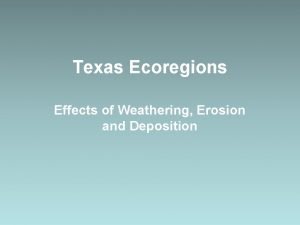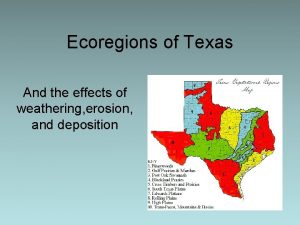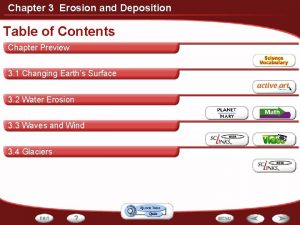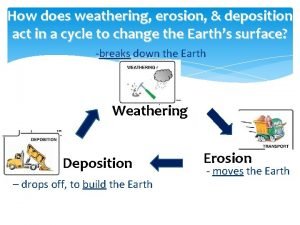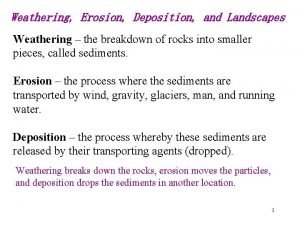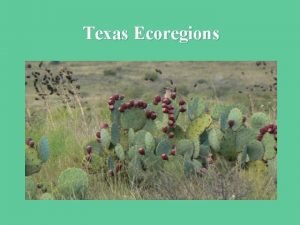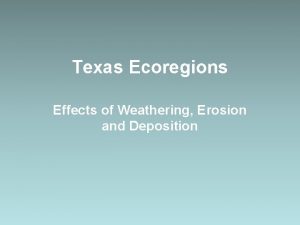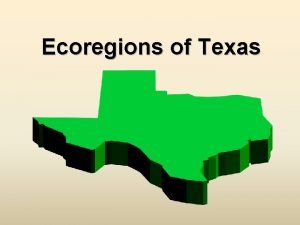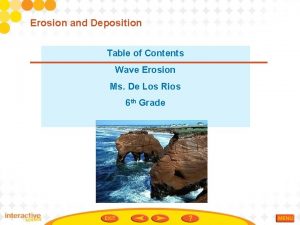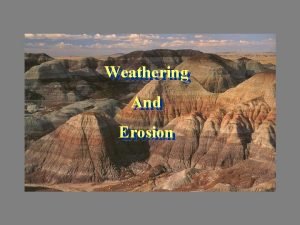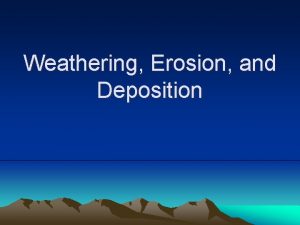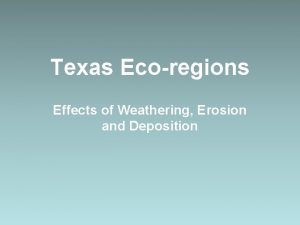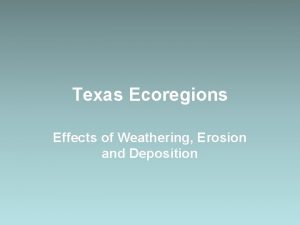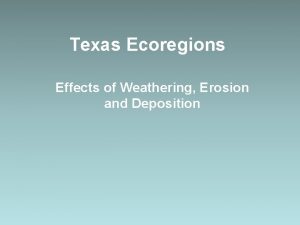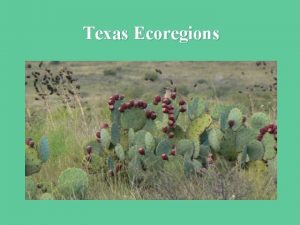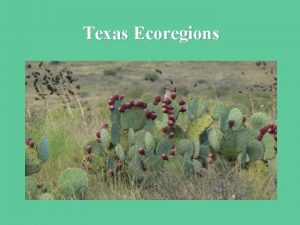Texas Ecoregions Effects of Weathering Erosion and Deposition












- Slides: 12

Texas Ecoregions Effects of Weathering, Erosion and Deposition

Factors Affecting Our Ecoregions Weathering – chemical and physical break down of rocks into sediment Erosion – the movement of sediment from one place to another Deposition – the placement of sediment after being carried from place of origin

CHEMICAL WEATHERING • THE PROCESS THAT BREAKS DOWN ROCKS BY CHEMICAL CHANGES OR REACTIONS. • Carbonation • Hydrolysis • Oxidation

PHYSICAL WEATHERING • THE PROCESS THAT BREAKS DOWN ROCKS BY PHYSICAL MEANS • Exfoliation • Ice wedging

1. Piney Woods 1. This ecoregion is found in Southeast Texas. 2. It is the wettest region of the state. This allows for a high rate of decomposition to occur resulting in healthy, nutrient-rich soils. 3. The topography is gently rolling to near flat through out the region. 4. Pine trees, woody vines, and hardwood trees dominate the vegetation.

2. Western Gulf Coastal Plain 1. Soil in the region is primarily sand-based. 2. If there isn’t enough vegetation to keep the soil in place, rainfall received can cause severe erosion. 3. Catastrophic events such as hurricanes can increase wave erosion and deposition.

3. Blackland Prairie & Post Oak Savannah 1. These areas have nutrientrich soils and receive good amounts of rainfall through the year. 2. If the land is clear-cut of natural vegetation for construction, nutrients can easily be eroded. 3. If the land is used for farming and it is not managed well, nutrients will be quickly used up.

4. Edwards Plateau 1. This region is located between dry western plains and moist prairies and woods. 2. Unfortunately, erosion has left most of the region with very shallow soils (less than 10 inches) lined with limestone rock layers. 3. High amounts of rain in a short amount of time can cause flash flooding.

5. Rolling Plains 1. This region is part of the Great Plains of the central United States. 2. Soils in this area are most fertile and sought after for crop production. 3. Periods of drought and then sudden increase in rainfall causes large amounts of erosion and deplete the soil of nutrients.

6. Western and Eastern Cross Timbers 1. This is a small, thin region running North to South on either side of the prairies and plains. 2. The soil is not as prone to flooding because it allows water to infiltrate very easily. 3. The region is described as rough, hilly terrain.

7. Mountain Forest / West Texas 1. Home of the tallest mountain in Texas, Guadalupe Peak. Elevation is 8, 749 feet. 2. Pines and Oaks dominate the tree species. 3. Soils are shallow and rocky. Weathering continues to play a role in developing soil and will for thousands of years to come. 4. Soils in the canyon bottoms and valleys are deeper as a result of deposition.

Summary Chemical weathering – changes mineral composition of rocks. Physical weathering–rocks are broken into smaller pieces.
 Edwards plateau weathering
Edwards plateau weathering Piney woods erosion
Piney woods erosion South texas brush country weathering
South texas brush country weathering How does weathering affect the gulf coast plains?
How does weathering affect the gulf coast plains? Weathering erosion and deposition
Weathering erosion and deposition What is deposition? *
What is deposition? * Pictures of different agents of soil erosion
Pictures of different agents of soil erosion South texas plains ecoregion
South texas plains ecoregion Texas ecoregions
Texas ecoregions Coastal sand plains texas
Coastal sand plains texas How do waves cause erosion and deposition
How do waves cause erosion and deposition Explain how water erosion by groundwater can form a cave.
Explain how water erosion by groundwater can form a cave. Agents of erosion
Agents of erosion

